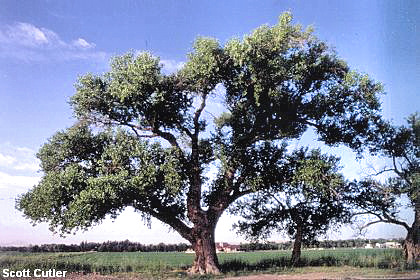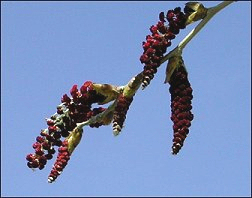

People throughout the Chihuahuan Desert region have long recognized the appearance of cottonwood catkins as a sign of spring. Catkins, which bear either male or female flowers, are named for their imagined resemblance to a cat's tail. By late spring, thousands of cottony seeds sail through the air, landing almost anywhere. People bestowed the tree with its name, of course, because of its messy seed dispersal.
Cottonwoods are typically found in flood plains, also known as riparian areas, and the once common flooding of the river helped the seeds germinate and grow into some of the largest trees in our desert.
These trees have a long history in the Chihuahuan Desert. Native
peoples ate the inner bark to prevent scurvy, and the flowering catkins were eaten raw.
Twigs were used to weave baskets, and the wood was used for home construction.
Undoubtedly, people have enjoyed the trees' shade for countless generations.
Cottonwood catkins herald in springtime, much as those of the Pussy Willow do in the
eastern United States. And although cacti are common throughout the drier countryside,
look for cottonwoods when you see a Chihuahuan Desert waterway.

Listen to the Audio (mp3 format) as recorded by KTEP, Public Radio for the Southwest.
Contributor: Arthur H. Harris, Laboratory for Environmental Biology, Centennial Museum, University of Texas at El Paso.
Desert Diary is a joint production of the Centennial Museum and KTEP National Public Radio at the University of Texas at El Paso.

A mature cottonwood tree. Photograph by Scott M. Cutler.

Cottonwood catkins in late March, El Paso, Texas. Photograph by A.H. Harris.
Cottonwoods belong to the genus Populus of the Salicaceae (Willow Family). The cottonwood of the Rio Grande and Trans-Pecos Texas is recognized under various names, including Populus fremontii var. wislizenii and Populus deltoides var. wislizenii.
Kearney, T. H., and R. H. Peebles. 1951. Arizona Flora. University of California Press, Berkeley. 1032 pp.